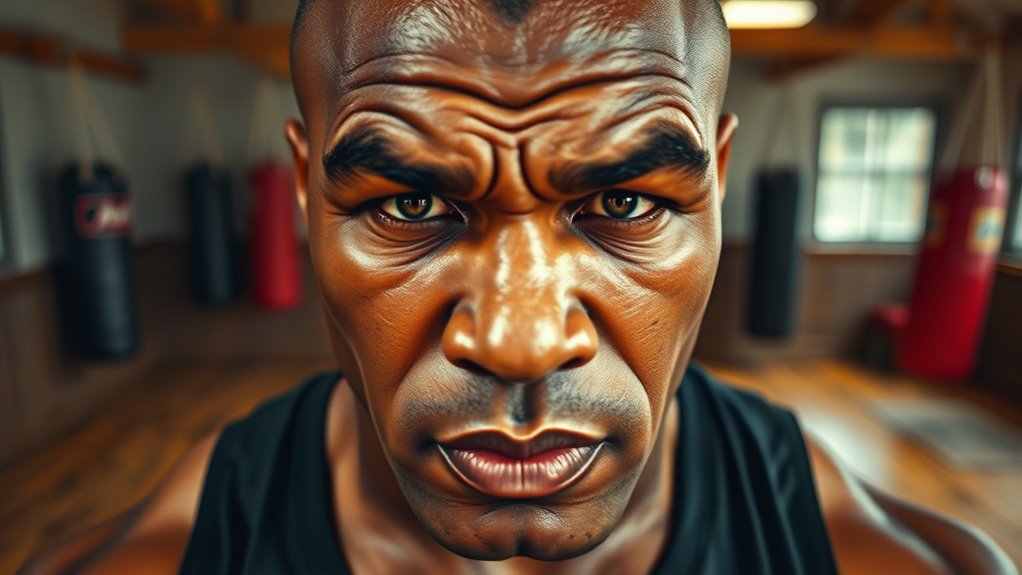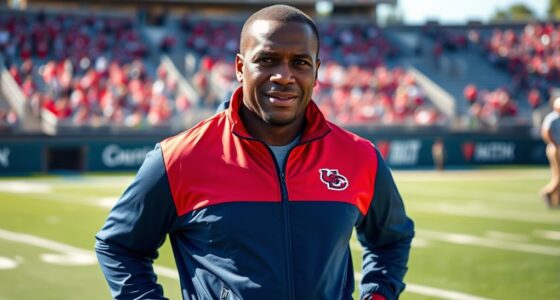Mike Tyson, once the youngest heavyweight champ at age 20, is known for his fierce power and aggressive style. His early life was marked by hardship, but he quickly rose to prominence with record-breaking wins and notable fights, including unifying heavyweight titles. His signature moves include relentless pressure and quick, powerful punches. Despite personal struggles and controversies, Tyson’s legacy as a transformative figure in boxing endures—understanding his journey reveals how he changed the sport forever.
Key Takeaways
- Mike Tyson became the youngest heavyweight champion at age 20 and held multiple major titles simultaneously.
- Known for his aggressive fighting style, rapid knockouts, and record-breaking achievements in boxing.
- His career included notable fights against legends like Evander Holyfield and Buster Douglas.
- Tyson faced personal and legal challenges, including a prison sentence and controversies that impacted his legacy.
- Inducted into boxing halls of fame, he remains one of the sport’s most influential and recognizable figures.
Early Life and Rise to Prominence

Mike Tyson was born on June 30, 1966, in Brooklyn’s Fort Greene neighborhood, where he faced a tough childhood marked by financial struggles and high-crime surroundings. Raised by his mother after his father left early, you can imagine the hardships he endured. His family moved to Bedford-Stuyvesant and then to Brownsville at age 10 due to poverty. Growing up in rough neighborhoods, he got involved in fights and petty crimes, even being arrested around 38 times by age 13. His aggressive behavior was often triggered by mockery of his voice and lisp. Sent to Tryon School for Boys at 12, his boxing talent was soon recognized. With mentorship from Cus D’Amato, Tyson’s raw potential eventually propelled him into the spotlight, transforming him into a boxing legend. Recognized for his early talent, Tyson quickly gained fame and became a dominant force in the heavyweight division.
Record-Breaking Achievements and Notable Fights
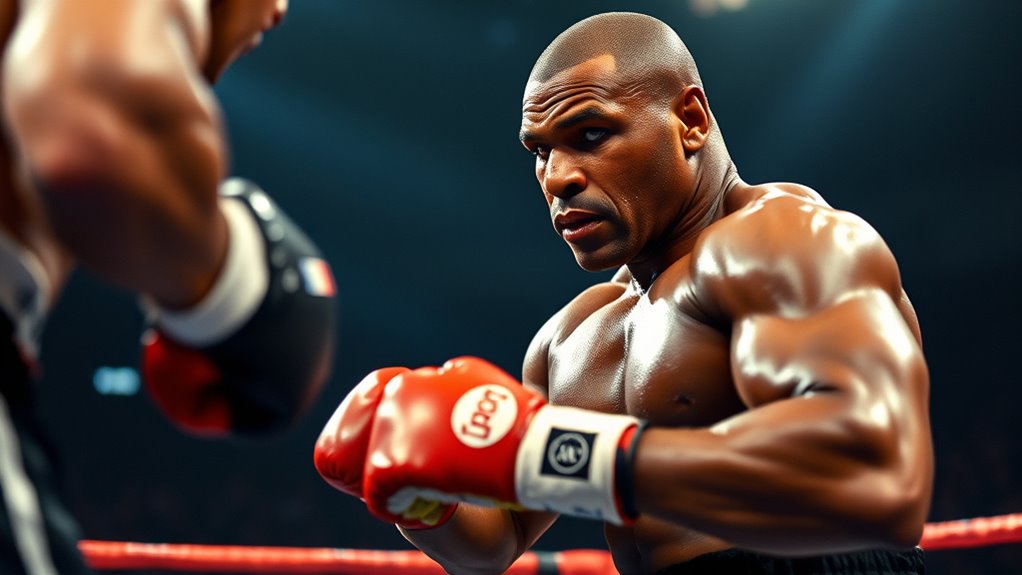
With a professional record of 50 wins, 6 losses, and 2 no contests, Tyson’s career is marked by record-breaking achievements that set him apart in boxing history. You witnessed his dominance early on, with 44 knockouts and only five losses by KO. At just 20, he became the youngest heavyweight champion ever and was the first to hold WBA, WBC, and IBF titles simultaneously. His winning streak included 18 consecutive knockouts, 12 in the first round, showcasing his power. Notable fights include his upset defeat by James “Buster” Douglas, considered boxing’s biggest upset, and controversial bouts like his disqualification against Holyfield. Tyson’s victories over legends like Holmes and Spinks highlight his era-defining impact, cementing his legacy as one of the sport’s most formidable fighters. Tyson’s record of 50 wins, 6 losses, and 2 no contests is one of the most impressive in heavyweight boxing history.
Fighting Style and Signature Techniques
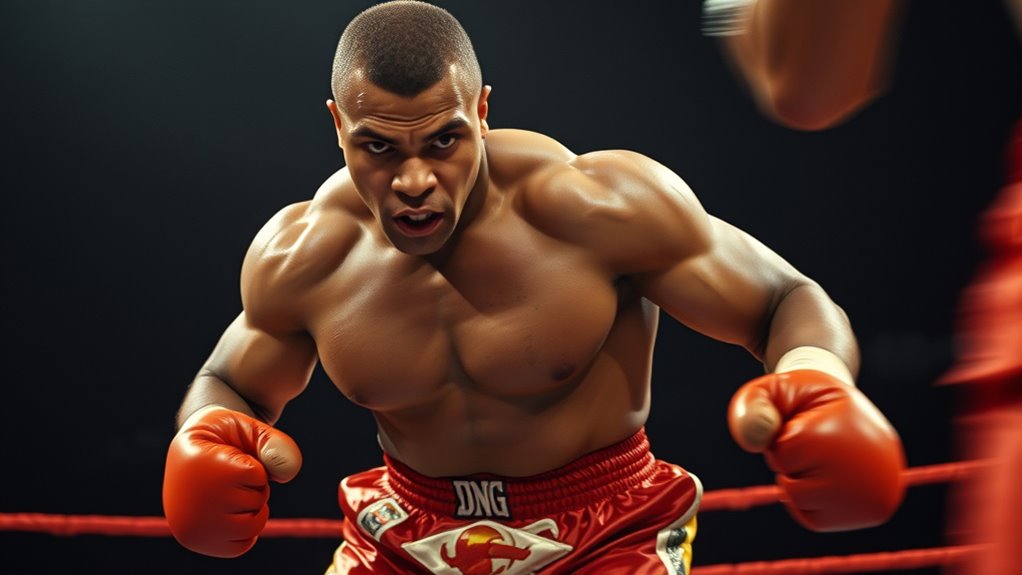
Tyson’s fighting style is defined by his aggressive, close-quarters approach and mastery of the Peek-a-Boo stance. You keep your hands high, elbows tucked, and stay crouched to protect your chin while maintaining full sight of your opponent. Your quick, compact punches target short-range areas, leveraging explosive power by transferring weight from your legs. You move constantly—bobbing, weaving, and shifting angles—to avoid punches and create openings. Your footwork is aggressive, pivoting and switching sides to attack from unexpected angles, keeping your opponent off-balance. You combine relentless pressure with rapid combinations of head and body shots, overwhelming opponents before they react. Your style relies on speed, power, and unpredictability, making it difficult for opponents to mount effective defenses against your aggressive, calculated assault. Constant head movement helps avoid incoming strikes and creates openings for counterattacks, while your adaptability in combat allows you to adjust tactics swiftly during fights.
Challenges, Controversies, and Personal Struggles
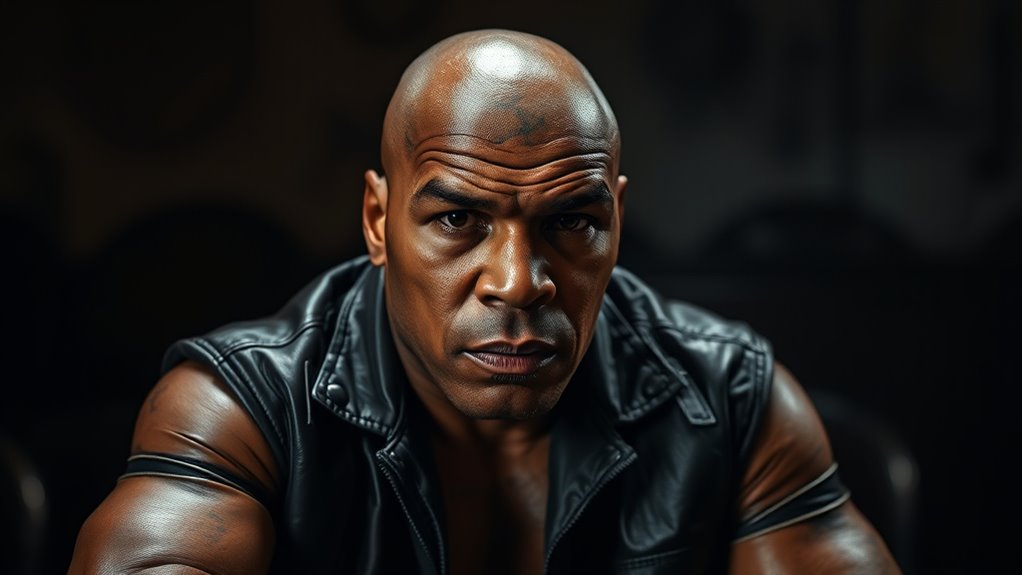
Despite his legendary status in the ring, Tyson’s career has been marred by a series of personal and legal challenges that have overshadowed his athletic achievements. In 1992, he was convicted of rape, serving three years of a six-year sentence, which drastically affected his career and reputation. Outside the ring, Tyson displayed violent behavior, most notoriously biting Evander Holyfield’s ear in 1997, leading to a lifetime ban (later lifted). Legal issues also included lawsuits from former trainers and promoters, draining his finances. His personal life was tumultuous, marked by early success, emotional struggles, and public outbursts. Disputes with managers and authorities, along with bouts of aggression and legal troubles, often overshadowed his boxing legacy, making his journey one of both triumph and ongoing adversity. Throughout his life, Tyson’s legal issues and personal struggles have been widely documented, reflecting the complex nature of his public image.
Legacy and Impact on the Sport

Mike Tyson’s dominance in the ring transformed the sport of boxing, leaving a lasting legacy that still influences fighters today. You see, he became the youngest heavyweight champion ever at just 20 years old and unified the major titles, setting a standard for future champions. His aggressive style combined speed and power, redefining what it means to be a heavyweight. Tyson’s early knockout streak, with 12 first-round wins, showcased his ferocity and dominance. Beyond titles, he inspired generations with his resilience, reclaiming the belts after setbacks. His influence extends off the ring, shaping boxing’s culture and style. Understanding the different roles in cybersecurity, such as ethical hacking and penetration testing, highlights the importance of specialized skills in protecting digital assets. Inducted into multiple halls of fame, Tyson’s legacy endures as a symbol of both raw power and transformative impact on heavyweight boxing. His revolutionary approach also helped elevate the sport’s global popularity and inspired a new generation of fighters.
Frequently Asked Questions
What Was Mike Tyson’s Training Regimen During His Peak Years?
During your peak, your training regimen would be intense and disciplined. You’d start early, doing extensive stretching, sprints, and plyometric exercises. Your days would include multiple boxing drills, sparring sessions, heavy bag work, jump rope, and calisthenics, often totaling 50-60 hours weekly. Nutrition and rest are vital, so you’d consume high-calorie, clean foods and get plenty of sleep. This rigorous routine pushes you to peak performance, just like a champion.
How Did Tyson Prepare Mentally for His Most Significant Fights?
You might think physical training is enough, but Tyson knew mental preparation was essential. He visualized himself as a champion before fights, using intense imagery and affirmations to build confidence. Under his coach’s guidance, hypnosis and aggressive self-talk conditioned his mind for dominance. By embracing struggle and pushing limits, he developed unwavering resilience. This mental toughness, combined with strategic thinking, helped him enter the ring with overwhelming confidence, often intimidating opponents before the first punch.
What Endorsements and Business Ventures Did Tyson Pursue Post-Retirement?
You’re curious about Tyson’s post-retirement ventures. He pursued a wide range of endorsements, including energy pouches, CBD products, and legal services, boosting his income and brand. He also engaged in entertainment, acting, and hosting podcasts to stay relevant. Additionally, he founded Tyson 2.0, a cannabis company, and promotes wellness products like testosterone therapy and psychedelic kits, expanding his entrepreneurial portfolio beyond boxing.
How Has Tyson Contributed to Boxing Outside of His Fighting Career?
Imagine a legendary figure stepping out of the ring onto the world stage, influencing boxing beyond his fights. You’ve seen how he pioneered techniques like the peek-a-boo style, revolutionized training methods, and promoted the sport globally. He’s mentored young fighters, championed safety reforms, and used media to keep boxing relevant. His efforts inspire new generations, making him a crucial ambassador for the sport’s growth, innovation, and cultural impact.
What Are Tyson’S Most Notable Activities and Appearances After Retiring From Boxing?
You see, after retiring, he stays very active through exhibitions, like his 2020 bout with Roy Jones Jr., and plans to fight Jake Paul in 2024. He also launched Legends Only League and promotes fights via Iron Mike Productions. Beyond boxing, he starred in *The Hangover*, did a Broadway show, and appears on podcasts and TV, maintaining a strong public presence and sharing his personal journey of redemption and advocacy.
Conclusion
As you reflect on Mike Tyson’s fierce punches and unyielding spirit, you can almost hear the thunder of his punches echoing through history. His journey, marked by triumph and turmoil, reminds you that greatness often emerges from chaos. Standing in the shadow of his legacy, you feel the raw power and relentless drive that transformed him into a legend. Tyson’s story lingers like a thunderclap—powerful, unforgettable, forever etched in the sport’s fabric.

